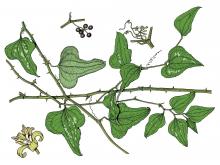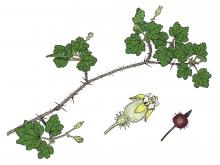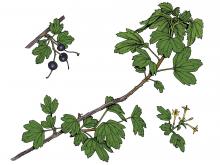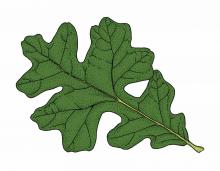Trees, Shrubs and Woody Vines
Media

Species Types
Scientific Name
Smilax hispida (syn. S. tamnoides var. hispida)
Description
Bristly greenbrier is a stout woody vine with bristlelike black spines, climbing high by tendrils to a length of 40 feet. It is the most common greenbrier in Missouri and is found statewide.
Media

Species Types
Scientific Name
Smilax bona-nox
Description
Catbrier is a green-stalked perennial vine with stout spines. It climbs up to 25 feet using tendrils that arise in pairs from the bases of the triangular, heart, or fiddle-shaped leaves.
Media

Species Types
Scientific Name
Quercus spp.
Description
Oaks are the most important group of trees in Missouri, in both human and ecosystem value. They dominate most of the forests, woodlands, and savannas in the state. Learn more about our 22 species.
Media

Species Types
Scientific Name
Ribes cynosbati
Description
Prickly gooseberry occurs mostly in the eastern half of Missouri. Its spine-covered berries turn reddish purple when ripe. Despite the prickles, they are edible.
Media

Species Types
Scientific Name
Ribes odoratum (syn. R. aureum)
Description
Golden currant is an erect to arching, spineless shrub up to 6 feet high that bears edible fruit. It is uncommon in the western part of the Ozarks. The flowers have a strong fragrance reminiscent of spicy cloves or sweet carnations.
Media

Species Types
Scientific Name
Ribes missouriense
Description
Missouri gooseberry is our state’s most widespread and common gooseberry. People brave its prickly stems to collect its tart, tasty fruits to make pies, jams, and jellies.
Media

Species Types
Scientific Name
Quercus stellata
Description
Post oak has long been favored for fence posts and was valued by American pioneers. It has distinctive cross- or ghost-shaped leaves. It grows in rocky upland woodlands and in flatwoods on broad ridges.
Media

Species Types
Scientific Name
Quercus coccinea
Description
Scarlet oak is a common tree of the Missouri Ozarks. Today it occupies much the same area that shortleaf pine used to dominate before it was extensively cut prior to the 1920s.
Media

Species Types
Scientific Name
Quercus marilandica
Description
Blackjack oak is common in dry upland woods, especially ones that have been badly burned. It can grow on the poorest soils. It is rugged but not worth much as lumber. It's one of the first trees to be used as fuel.
Media

Species Types
Scientific Name
Quercus alba
Description
Found throughout Missouri and in all kinds of habitats, the white oak is one of our most attractive, long-lived, and stately shade trees. Learn to recognize it by its light gray bark, rounded-lobed leaves, and distinctive acorns.
See Also
About Trees, Shrubs and Woody Vines in Missouri
There are no sharp dividing lines between trees, shrubs, and woody vines, or even between woody and nonwoody plants. “Wood” is a type of tissue made of cellulose and lignin that many plants develop as they mature — whether they are “woody” or not. Trees are woody plants over 13 feet tall with a single trunk. Shrubs are less than 13 feet tall, with multiple stems. Vines require support or else sprawl over the ground.





















